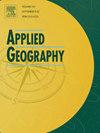沙特阿拉伯利雅得城市公园降温影响的效率和强度测量:公园降温方向指数的季节性分析与建议方法
IF 4
2区 地球科学
Q1 GEOGRAPHY
引用次数: 0
摘要
本研究利用2023年12月至2024年11月的Landsat 8和9图像,调查了沙特阿拉伯利雅得四个城市公园的冷却效率。分析集中在地表温度(LST)和归一化植被指数(NDVI)上,以考察降温效应的季节变化。在300米缓冲区内评估的冷却效率因季节和公园而异。夏季降温效率最高,可达172.5 m,冬季降温效率最低,为127.5 m。特定公园的表现存在显著差异。Al-Wadi公园尽管面积较小,但冷却效率最高,达到180米,超过了较大的阿卜杜拉国王公园(150米)。NDVI最高的Al-Salam公园降温效果最显著,夏季降温效果可达240 m。另一方面,Al-Suwaidi公园的整体效率最高,延伸至300米。在空间降温强度方面,Al-Salam Park的降温效果最强,东部降温5.4℃,西部降温4.7℃。季节性风型对降温方向也有影响,夏季向东降温最为明显。这些发现挑战了传统的假设,即更大的公园总是提供更大的冷却效益,而不是强调植被密度在城市热调节中的重要作用。该研究强调,在干旱城市中,需要战略性的公园设计,结合密集的植被和水体,以优化冷却效率,减轻城市热岛(UHI)效应。本文章由计算机程序翻译,如有差异,请以英文原文为准。
Measuring the efficiency and intensity of the cooling impact of urban parks in Riyadh, Saudi Arabia: Seasonal analysis and proposed approach to the parks cooling direction index
This study investigates the cooling efficiency of four urban parks in Riyadh, Saudi Arabia, utilizing Landsat 8 and 9 imagery from December 2023 to November 2024. The analysis focused on Land Surface Temperature (LST) and the Normalized Difference Vegetation Index (NDVI) to examine seasonal variations in cooling effects. Cooling efficiency, assessed within a 300-m buffer zone, varied across both seasons and parks. The highest seasonal cooling efficiency was observed in summer, extending up to 172.5 m, while the lowest occurred in winter at 127.5 m. Park-specific performance showed notable differences. Al-Wadi Park, despite its smaller size, exhibited the highest cooling efficiency, reaching 180 m, surpassing the larger King Abdullah Park at 150 m. Al-Salam Park, which had the highest NDVI, demonstrated the most significant cooling effect, with its influence extending up to 240 m in summer. Al-Suwaidi Park, on the other hand, recorded the highest overall efficiency, extending up to 300 m. In terms of spatial cooling intensity, Al-Salam Park produced the strongest cooling effects, with temperature reductions of 5.4 °C to the east and 4.7 °C to the west. Seasonal wind patterns also influenced the cooling direction, with eastward cooling being most prominent during summer. These findings challenge the conventional assumption that larger parks always provide greater cooling benefits, highlighting instead the essential role of vegetation density in urban thermal regulation. The study emphasizes the need for strategic park design that incorporates dense vegetation and water bodies to optimize cooling efficiency and mitigate Urban Heat Island (UHI) effects in arid cities.
求助全文
通过发布文献求助,成功后即可免费获取论文全文。
去求助
来源期刊

Applied Geography
GEOGRAPHY-
CiteScore
8.00
自引率
2.00%
发文量
134
期刊介绍:
Applied Geography is a journal devoted to the publication of research which utilizes geographic approaches (human, physical, nature-society and GIScience) to resolve human problems that have a spatial dimension. These problems may be related to the assessment, management and allocation of the world physical and/or human resources. The underlying rationale of the journal is that only through a clear understanding of the relevant societal, physical, and coupled natural-humans systems can we resolve such problems. Papers are invited on any theme involving the application of geographical theory and methodology in the resolution of human problems.
 求助内容:
求助内容: 应助结果提醒方式:
应助结果提醒方式:


